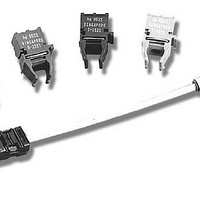HFBR-0566 Avago Technologies US Inc., HFBR-0566 Datasheet - Page 9

HFBR-0566
Manufacturer Part Number
HFBR-0566
Description
Fiber Optic Development Tools MT-RJ 622Mb/s Fast E Evaluation Kit
Manufacturer
Avago Technologies US Inc.
Datasheet
1.HFBR-0566.pdf
(17 pages)
Specifications of HFBR-0566
Description/function
Fiber Optic Kit
For Use With/related Products
HFBR-5908E, HFCT-5908E
Lead Free Status / RoHS Status
Lead free / RoHS Compliant
Electromagnetic Interference (EMI)
One of a circuit board designer’s foremost concerns is
the control of electromagnetic emissions from electronic
equipment. Success in controlling generated Electromag-
netic Interference (EMI) enables the designer to pass a
governmental agency’s EMI regulatory standard and more
importantly, it reduces the possibility of interference to
neighboring equipment. Avago has designed the HFBR/
HFCT-5908E to provide excellent EMI performance. The EMI
performance of a chassis is dependent on physical design
and features which help improve EMI suppression. Avago
encourages using standard RF suppression practices and
avoiding poorly EMI-sealed enclosures.
Radiated Emissions for the HFBR/HFCT-5908E have been
tested successfully in several environments. While this
number is important for system designers in terms of
emissions levels inside a system, Avago recognizes that
the performance of most interest to our customers is the
emissions levels, which could be expected to radiate to
the outside world from inside a typical system. In their
application, SFF transceivers are intended for use inside an
enclosed system, protruding through the specified panel
opening at the specified protrusion depth.
Along with the system advantage of high port density
comes the increase in the number of apertures. Careful
attention must be paid to the locations of high-speed
clocks or gigabit circuitry with respect to these apertures.
While experimental measurements and experiences do not
indicate any specific transceiver emissions issues, Avago
recognizes that the transceiver aperture is often a weak
link in system enclosure integrity and has designed the
modules to minimize emissions and contain the internal
system emissions by shielding the aperture.
To that end, Avago’s OC-12/STM-4 MT-RJ transceivers
(HFCT-5908E and HFBR-5908E) have nose shields which
provide a convenient chassis connection to the nose of
the transceiver. This nose shield improves system EMI
performance by closing off the MT-RJ aperture. Localized
shielding is also improved by tying the four metal housing
package grounding tabs to signal ground on the PCB.
Though not obvious by inspection, the nose shield and
metal housing are electrically separated for customers
who do not wish to directly tie chassis and signal grounds
together. The recommended transceiver position, PCB
layout and panel opening for both HFBR/HFCT-5908E are
the same, making them mechanically drop-in compatible.
Figure 7 shows the recommended positioning of the trans-
ceivers with respect to the PCB and faceplate.
9
Package and Handling Instructions
Flammability
The HFBR/HFCT-5908E transceiver housing consists of high
strength, heat resistant, chemically resistant, and UL 94 V-0
flame retardant plastic and metal packaging.
Recommended Solder and Wash Process
The HFBR/HFCT-5908E is compatible with industry-
standard wave or hand solder processes.
Process plug
This transceiver is supplied with a process plug for protec-
tion of the optical port within the MT-RJ connector recep-
tacle. This process plug prevents contamination during
wave solder and aqueous rinse as well as during handling,
shipping and storage. It is made of a high-temperature,
molded sealing material that can withstand +80°C and a
rinse pressure of 110 lbs per square inch.
Recommended Solder fluxes
Solder fluxes used with the HFBR/HFCT-5908E should be
water-soluble, organic fluxes. Recommended solder fluxes
include Lonco 3355-11 from London Chemical West, Inc.
of Burbank, CA, and 100 Flux from Alpha-Metals of Jersey
City, NJ.
Recommended Cleaning/ Degreasing Chemicals
Alcohols: methyl, isopropyl, isobutyl.
Aliphatics: hexane, heptane
Other: naphtha.
D o not use p a r t i a l l y h a l o g e n a t e d hy d ro c a r -
bons such as 1,1.1 tr ichloroethane, ketones
such as MEK, acetone, chloroform, ethyl acetate,
methylene dichloride, phenol, methylene chloride, or
N-methylpyrolldone. Also, Avago does not recommend
the use of cleaners that use halogenated hydrocarbons
because of their potential environmental harm.
























